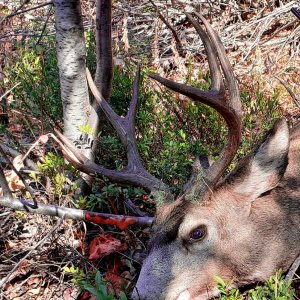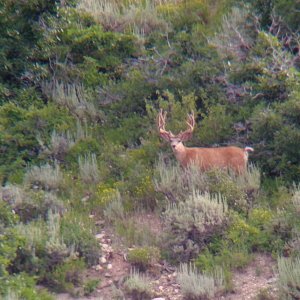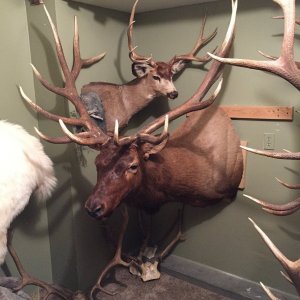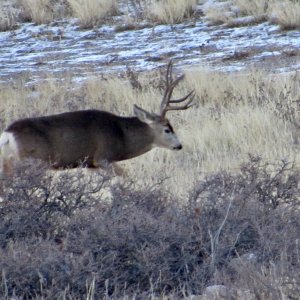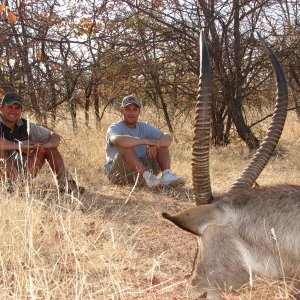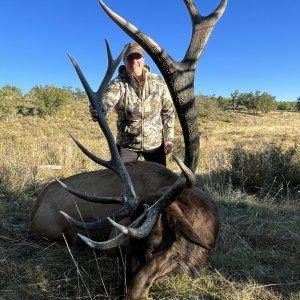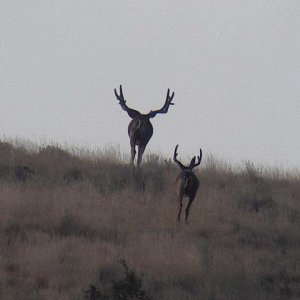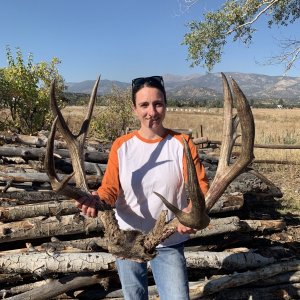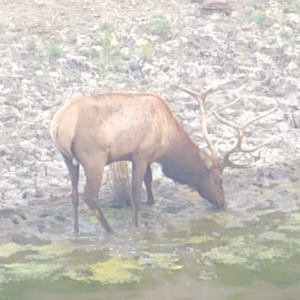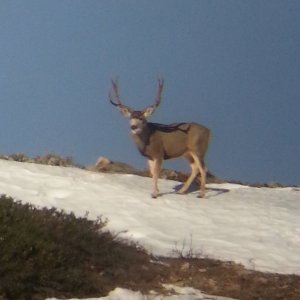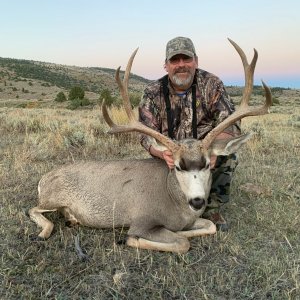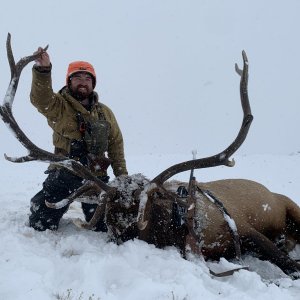You are using an out of date browser. It may not display this or other websites correctly.
You should upgrade or use an alternative browser.
You should upgrade or use an alternative browser.
Mule deer Decline
- Thread starter quest
- Start date
H
huntindude
Guest
The decline in Oregon has slowed dramatically, we only lost 2 dear last year, dropping from 13 to 11.
ODFW's objective level for the state is 10 mule deer, so they don't see any problems yet.
ODFW's objective level for the state is 10 mule deer, so they don't see any problems yet.
I
isayNUNYA
Guest
fish and game departments, office biologists
"I'll keep my Freedom, I'll keep my Money, I'll keep my guns! You keep the change.
---------------------------------------
"I needed a cheesy signature saying like everyone else"
"I'll keep my Freedom, I'll keep my Money, I'll keep my guns! You keep the change.
---------------------------------------
"I needed a cheesy signature saying like everyone else"
sageadvice
Long Time Member
- Messages
- 11,849
I'll throw in a vote for Cali. I know, I know, nobody's going to vote for Cali and who cares, Right? Right! But we do. Our traditional mule deer ranges, especially in the North Eastern part of the State have been hurting and getting worse going on now since the harsh winters of 92-93. The predator situation just will not allow the animals to hold their own, let alone rebound.
Joey
Joey
Daxter
Very Active Member
- Messages
- 1,425
You seriously think F&G Departments and their biologists are the major cause for declines to mule deer? Perhaps the liberal doe hunting back in the day took its toll, but most western states currently manage their deer populations to allow for population growth with a very limited doe harvest. The growth potential of a population has way more to do with does than it does bucks. If you want to point fingers for an overall decline in buck quality, then F&G departments are the first ones to look at.
As far as why deer populations are declining I would say;
HABITAT. Large scale changes to vegetation and mule deer habitats, largely caused by livestock grazing, drought, wildfire suppression, and the biggie, human development.
ROADS. Increased number of roads = more habitat lost or rendered less valuable, migration routes fragmented, and huge increases in deer vehicle collisions.
PREDATORS. I would say predators are probably more responsible for holding depressed populations down, rather than pulling them down in the first place. However, I think their role is significant.
ELK. Elk compete with deer for resources and space. Elk populations have grown by leaps and bounds as mule deer pops continue to decline. Part of that may be due to vegetation changes and how they favor the diets of elk vs. deer, but elk numbers do have an impact on deer populations, especially in areas with limited winter range. The diet overlap between elk and deer is highest in the winter, and the harder the winter the more similar their diets are.
Dax
As far as why deer populations are declining I would say;
HABITAT. Large scale changes to vegetation and mule deer habitats, largely caused by livestock grazing, drought, wildfire suppression, and the biggie, human development.
ROADS. Increased number of roads = more habitat lost or rendered less valuable, migration routes fragmented, and huge increases in deer vehicle collisions.
PREDATORS. I would say predators are probably more responsible for holding depressed populations down, rather than pulling them down in the first place. However, I think their role is significant.
ELK. Elk compete with deer for resources and space. Elk populations have grown by leaps and bounds as mule deer pops continue to decline. Part of that may be due to vegetation changes and how they favor the diets of elk vs. deer, but elk numbers do have an impact on deer populations, especially in areas with limited winter range. The diet overlap between elk and deer is highest in the winter, and the harder the winter the more similar their diets are.
Dax
B
Bullelk1
Guest
Daxter, The old days of doe killing are still here in Idaho. One of our State senators owns a sheep ranch (and a high fence hunting operation) west of the town of Ashton, in the middle of prime wintering area for deer and elk. He has successfully pushed for a doe season for several years, and the toll on the deer population is devistating. It is one of the biggest political scams I have ever witnessed, but he is a connected good ole boy who does what suits him to the detriment of our wildlive.
R
rumproast
Guest
Pulling teeth, employing the Rack, threatening the Noose, Castration, etc. seems to be coming around to being effective in Wyo. on the behind-doors kind of approach and need.
Reckon we'll have an issue on our hands by next Leg. session dealing with pref. pts. for us Rezzes concerning the Mulie, among but not exclusive of other big game herd issues.
Reckon we'll have an issue on our hands by next Leg. session dealing with pref. pts. for us Rezzes concerning the Mulie, among but not exclusive of other big game herd issues.
fatrooster
Long Time Member
- Messages
- 4,187
I would say that Idaho and Wyoming are in the lead for decline for the reason stated above. Too many over the counter tags. Colorado also experienced this problem years ago and turned it around and is now the premium state to hunt mulies. fatrooster.
4
4000fps
Guest
Colorado still has its problems. They still issue doe tags, and bucks are still getting murdered due to the 4th season.
S
SMELLYBUCK
Guest
h.d.
Thanks for the laugh.
Thanks for the laugh.
S
SMELLYBUCK
Guest
I was recently reminded that Texas had a population explosion of cattle while all the cattlemen went off to the Civil War. The cattle population was left alone and the cattlemen came home to approximately 6,000,000 head. This gave rise to the famous cattle drives. (A bunch of unbranded cattle and new markets opened.)
Maybe the hunting was so great in the 40's - 60's because of all the wars.
My biggest question right now is why don't deer populations recover faster? If only 25% of the herd consists of does that can have fawns, the population can double in less than 4 years.
Utah still hasn't recovered to a population level observed before the 1993 winter kill. With as heavy % we are on does, you'd think we would have hit 400,000 plus years ago.
Maybe the hunting was so great in the 40's - 60's because of all the wars.
My biggest question right now is why don't deer populations recover faster? If only 25% of the herd consists of does that can have fawns, the population can double in less than 4 years.
Utah still hasn't recovered to a population level observed before the 1993 winter kill. With as heavy % we are on does, you'd think we would have hit 400,000 plus years ago.
S
scoutdog5
Guest
I think Oregon is the winner here hands-down. Huntindude exagerates, but only slightly.
Best guess, there were more than 500,000 mule deer in Oregon in 1970. Current population is less than 200,000 and dropping like a rock.
Dax, I am always perplexed by the elk argument. I have asked numerous biologists who have used this as an excuse for decreasing mule deer populations a very simple question, without ever getting a logical answer, so will try it out on you.
Colorado is approximately the same geopgraphic size as Oregon, Wyoming, and Utah, smaller than Montana. Compared to Oregon, smaller winter range in many areas. In 2007, Colorado had 285,000 elk, and slightly more than 600,000 mule deer, far and away the highest numbers of both species in the country. If population growth in elk herds is a limiting factor for mule deer herds, how is this possible?
Oregon has not issued doe tags in significant numbers for more than 25 years in most units, yet deer herds continue to crash. What they do issue is large numbers of buck tags given the population base, and as a result, most herds have very small numbers of mature bucks. Last year, Oregon issued 55,000 buck tags on a population that averages less than 200,000 animals, with a buck/doe ratio of less than 15/100. Colorado issued fewer buck tags on a population that exceeds 500,000 (guestimate after last years winter kill) with a statewide buck ratio that exceeds 30/100.
In Oregon, herds have dropped so low that I don't believe habitat is currently having any significant impact. Predation is certainly a big part of the problem, and there is little hope that things will get better in that regard.
Various studies have shown that when mature males are available to do the breeding, fawns/calves are born earlier, the length of time when fawns/calves are vulnerable after birth is shortened, and fawn/calf survival to one year of age is significantly inceased. In my view, Colorado's decision to reduce buck tags by 1/2 in 1999 led to a significant increase in mature bucks in most herds a few years later, and is the primary factor that led to the increase in their mule deer population from 475,000 in 1998 to over 600,000 in 2007. No other state has been successful in significantly increasing their mule deer population during that time frame.
Scoutdog
Best guess, there were more than 500,000 mule deer in Oregon in 1970. Current population is less than 200,000 and dropping like a rock.
Dax, I am always perplexed by the elk argument. I have asked numerous biologists who have used this as an excuse for decreasing mule deer populations a very simple question, without ever getting a logical answer, so will try it out on you.
Colorado is approximately the same geopgraphic size as Oregon, Wyoming, and Utah, smaller than Montana. Compared to Oregon, smaller winter range in many areas. In 2007, Colorado had 285,000 elk, and slightly more than 600,000 mule deer, far and away the highest numbers of both species in the country. If population growth in elk herds is a limiting factor for mule deer herds, how is this possible?
Oregon has not issued doe tags in significant numbers for more than 25 years in most units, yet deer herds continue to crash. What they do issue is large numbers of buck tags given the population base, and as a result, most herds have very small numbers of mature bucks. Last year, Oregon issued 55,000 buck tags on a population that averages less than 200,000 animals, with a buck/doe ratio of less than 15/100. Colorado issued fewer buck tags on a population that exceeds 500,000 (guestimate after last years winter kill) with a statewide buck ratio that exceeds 30/100.
In Oregon, herds have dropped so low that I don't believe habitat is currently having any significant impact. Predation is certainly a big part of the problem, and there is little hope that things will get better in that regard.
Various studies have shown that when mature males are available to do the breeding, fawns/calves are born earlier, the length of time when fawns/calves are vulnerable after birth is shortened, and fawn/calf survival to one year of age is significantly inceased. In my view, Colorado's decision to reduce buck tags by 1/2 in 1999 led to a significant increase in mature bucks in most herds a few years later, and is the primary factor that led to the increase in their mule deer population from 475,000 in 1998 to over 600,000 in 2007. No other state has been successful in significantly increasing their mule deer population during that time frame.
Scoutdog
4
4000fps
Guest
Colorado only has speculation of our herd size, and harvest data. I do not believe the numbers. I have lived in mulie country most of my life, and have yet to see this "miraculous" comeback. Mulie hunting was better, even in the mid 90's, than it is now.
Predation is the #1 reason for the decline in muleys nationwide coupled with the drought. Yes there have been losses from habitat, hunting pressure etc but if you look at tag numbers today most states are offering fewer tags than they were back in the 90's. We have a unit in AZ that has a large fenced enclosure and a supply of deer inside the enclosure. The deer counts within the enclosure that is predator free are substantiallly higher then those outside in the same habitat and have been for years. People today don't shoot predators and there is too much public pressure not to have coyote contests etc so it's a delicate issue for our fish and game departments. If we were to remove more predators in all states and reduce tags a bit in the process the numbers would start to bounce back. Remember that we have had a drought out west for most of the last 10 years and that also advesely effects fawn survival and breeding. In drought cycles most does won't drop multiple fawns so that causes numbers to drop too and if conditions are poor enough some does don't breed.
I have seen an increase in deer numbers and mature buck quality. And last year when we had the big snow and all the deer where concentrated in feed areas the DOW was not to far off on there herd count from the year before. Deer hunting in CO is much better now than it was in the 90s for sure. You can rag on CO all you want but we have the best management for quality deer. Hunt other states and you will find out for yourself.
JC
JC
The original question was "what state is number one for mule deer decline"? We can point fingers at various state agencies all day long. But here's what is most disturbing to me.
Every big game species in the lower 48 is more abundant than they were 25 years ago, 50 years ago, or 75 years ago. Except for mule deer!!! Why concern ourselves with which state is the worst when the mule deer population in EVERY state is so far below historic levels. I believe mule deer populations have declined for a variety of reasons resulting in a "perfect storm" to which mule deer are the most vulnerable.
Habitat encroachment, fragmention and development. Loss of winter range, drought, wildfire mitigation, competition from other game etc. all contribute to the mule deers inability to thrive. But I believe one factor above all others is responsible for the mule deers decline. Lack of predator management!
During WW II the allied armies needed meat and wool. As much as they could get. The "government trapper" became a key player in the war effort. These men worked 365 days a year with bullets, traps and poisons. Government trappers took huge numbers of coyotes, bobcats, bears and mountain lions. You can track a definate and direct correlation between the harvests of the government trappers and the expansion of mule deer populations. By the mid sixties mule deer populations were at the highest numbers anyone could recall.
Then predator management changed. Black bears and mountain lions became classified as "big game". Government trappers became politically incorrect and their jobs evaporated. Poisons became outlawed by the seventies. It took a couple decades for the predator populations to expand but they have.
You put all of these factors together and Wildlife Agencies have little chance of "managing" mule deer back to their glory days.
Every big game species in the lower 48 is more abundant than they were 25 years ago, 50 years ago, or 75 years ago. Except for mule deer!!! Why concern ourselves with which state is the worst when the mule deer population in EVERY state is so far below historic levels. I believe mule deer populations have declined for a variety of reasons resulting in a "perfect storm" to which mule deer are the most vulnerable.
Habitat encroachment, fragmention and development. Loss of winter range, drought, wildfire mitigation, competition from other game etc. all contribute to the mule deers inability to thrive. But I believe one factor above all others is responsible for the mule deers decline. Lack of predator management!
During WW II the allied armies needed meat and wool. As much as they could get. The "government trapper" became a key player in the war effort. These men worked 365 days a year with bullets, traps and poisons. Government trappers took huge numbers of coyotes, bobcats, bears and mountain lions. You can track a definate and direct correlation between the harvests of the government trappers and the expansion of mule deer populations. By the mid sixties mule deer populations were at the highest numbers anyone could recall.
Then predator management changed. Black bears and mountain lions became classified as "big game". Government trappers became politically incorrect and their jobs evaporated. Poisons became outlawed by the seventies. It took a couple decades for the predator populations to expand but they have.
You put all of these factors together and Wildlife Agencies have little chance of "managing" mule deer back to their glory days.
M
mesquitehunter
Guest
I would have to agree with you Uphill.
As the greenies and bark lickers get laws passed based on emotion such reintroduction of wolves, grizzly bears and as in Cali. outlawing moutian lion hunting or in Az banning leg hold traps. While they are trying to figure out how they can make the country more like Disney they have no idea that the house there living in could have been in some prime habitat several years ago.
As the greenies and bark lickers get laws passed based on emotion such reintroduction of wolves, grizzly bears and as in Cali. outlawing moutian lion hunting or in Az banning leg hold traps. While they are trying to figure out how they can make the country more like Disney they have no idea that the house there living in could have been in some prime habitat several years ago.
4
4000fps
Guest
Do you guys honestly believe that predators kill more deer than humans? I don't think a bunch of 30 pound coyotes are killing 50,000 deer a year in CO, like us hunters.
There isn't even a high coyote density in most of Colorado's mulie country. The highest number of dogs are found in the eastern plains, and deserts.
How many hunters would be willing to not kill a deer for the next three years, to bring herd numbers back? Not that it would ever happen, the DOW needs the revenue from license sales.
There isn't even a high coyote density in most of Colorado's mulie country. The highest number of dogs are found in the eastern plains, and deserts.
How many hunters would be willing to not kill a deer for the next three years, to bring herd numbers back? Not that it would ever happen, the DOW needs the revenue from license sales.
grizzly
Long Time Member
- Messages
- 5,596
A fawn mortality study at USU about 5 years ago found 90% of fawn mortality was coyote caused.
My personal discussions with biologists has found lack of wildfires (fawns need new-growth aspens, which grow after wildfires), too many elk (elk push deer out of prime fawning ground), destruction of winter range, a few hard winters, and predators are all major causes of mule deer decline.
Too many tags definitely contributes as well. I have even heard some hypothesize that Utah issues more Northern general buck tags than there are bucks available. Then the DWR claims 1/3 success rate on the Cache. I bet the actual success rate is closer to 1/10.
Grizzly
My personal discussions with biologists has found lack of wildfires (fawns need new-growth aspens, which grow after wildfires), too many elk (elk push deer out of prime fawning ground), destruction of winter range, a few hard winters, and predators are all major causes of mule deer decline.
Too many tags definitely contributes as well. I have even heard some hypothesize that Utah issues more Northern general buck tags than there are bucks available. Then the DWR claims 1/3 success rate on the Cache. I bet the actual success rate is closer to 1/10.
Grizzly
Daxter
Very Active Member
- Messages
- 1,425
Scoutdog 5,
While it is not possible to prove causality, and I freely admit that some of the decline in deer populations and increase in elk is due to large scale vegetation changes, to say that the two species don't compete is illogical.
The level and significance of any competition is dependent on the degree of limitation of the commonly desired resource. I will concede that in Colorado, a state that arguably contains more suitable deer and elk habitat than any other state, that competition may be less intense than it is in other states with more limited habitat. When you leave the Colorado Plateau ecotype and enter the intermountain west, basin and range ecotype (http://www.createstrat.com/muledeerinthewest/regions.html) you enter mule deer and elk ranges with generally lower precipitation, lower quality feeds, and reduced habitat connectivity. I believe that competition becomes more significant in these areas where the commonly desired resources are more limited.
I do not believe that elk are single handedly responsible for declines to mule deer populations, but in my mind I can't understand how they could not be a contributing factor.
Dax
Some additional reading on the elk vs. deer subject
http://www.createstrat.com/muledeerinthewest/elkandmuledeer.html
http://westinstenv.org/wibio/2009/0...ndition-of-shrubs-on-mule-deer-winter-ranges/
While it is not possible to prove causality, and I freely admit that some of the decline in deer populations and increase in elk is due to large scale vegetation changes, to say that the two species don't compete is illogical.
The level and significance of any competition is dependent on the degree of limitation of the commonly desired resource. I will concede that in Colorado, a state that arguably contains more suitable deer and elk habitat than any other state, that competition may be less intense than it is in other states with more limited habitat. When you leave the Colorado Plateau ecotype and enter the intermountain west, basin and range ecotype (http://www.createstrat.com/muledeerinthewest/regions.html) you enter mule deer and elk ranges with generally lower precipitation, lower quality feeds, and reduced habitat connectivity. I believe that competition becomes more significant in these areas where the commonly desired resources are more limited.
I do not believe that elk are single handedly responsible for declines to mule deer populations, but in my mind I can't understand how they could not be a contributing factor.
Dax
Some additional reading on the elk vs. deer subject
http://www.createstrat.com/muledeerinthewest/elkandmuledeer.html
http://westinstenv.org/wibio/2009/0...ndition-of-shrubs-on-mule-deer-winter-ranges/
H
huntindude
Guest
It has to be predation. I hunt the same areas I hunted as a kid in the 60's. it was grazed WAY harder in those days and we had deer everywhere, no loss of habitat to humans or anything else in my part of the state, so forget habitat.
In the 70's we lost the use of 1080 on coyotes by ranchers and govt trappers, and slowly we watched the deer herds decline until the winter of 92-93 when they got hammered. in '94 we lost the right to hunt lions with dogs, around the same time Coyote pelts dropped in value and interest in killing them dropped. even after the awful winter of 92-93 we had more deer than we had 10 years later and it gets worse as we speak.
Do the math its pretation at least in Oregon anyway, I don't care how many million dollars ODFW spends to study it to death there's no debate about it.
In the 70's we lost the use of 1080 on coyotes by ranchers and govt trappers, and slowly we watched the deer herds decline until the winter of 92-93 when they got hammered. in '94 we lost the right to hunt lions with dogs, around the same time Coyote pelts dropped in value and interest in killing them dropped. even after the awful winter of 92-93 we had more deer than we had 10 years later and it gets worse as we speak.
Do the math its pretation at least in Oregon anyway, I don't care how many million dollars ODFW spends to study it to death there's no debate about it.
H
HuntingGear
Guest
Colorado gets my #1 vote.
Utah close behind that.
The states need to figure out how to manage the $$$$ they get from from the tags they sell, and stop selling tags just to get $$$$$ when the herds are down.
Also as sportsmen if you go out the herds have been hit hard with winter kill like last year, "TURN YOUR TAG BACK OR JUST EAT IT".
Last season people were filling doe tags and killing any 2 point they could find because they spent $300.00 on a tag.
Those few deer left are the future herd!!!!!!!!!!!!
Utah close behind that.
The states need to figure out how to manage the $$$$ they get from from the tags they sell, and stop selling tags just to get $$$$$ when the herds are down.
Also as sportsmen if you go out the herds have been hit hard with winter kill like last year, "TURN YOUR TAG BACK OR JUST EAT IT".
Last season people were filling doe tags and killing any 2 point they could find because they spent $300.00 on a tag.
Those few deer left are the future herd!!!!!!!!!!!!
M
mesquitehunter
Guest
Lion hunting without dogs. WOW that was a sneaky way to stop lion hunting without actually banning it. I know here in AZ coyotes feed more on the fawns during dryer years because there's fewer rabbits. I have witnessed many times coyotes working as a pack trying to get a fawn out of a herd of does.
Dude, I can't beleive it! We are agreeing on something again. The ban of poison, leg hold traps, and the ban on mountain lions, has devastated the herds here in the Eastern Sierra, of California.
The D.F.G. have been studying fawn mortality on the round valley herd for four years. What they have been doing is netting does on the winter range, collering them, giving them a ultra sound to see if they are pregnent,then tracking them to their summer range, by the gps coller. Fish and Game then has a few ground personell to check the collered does when they give birth. Almost always, twins are born,but after a few weeks,one or both are gone. The findings are starteling, predation seems to be the largest cause of death. Coyotes are the biggest problem, followed by black bears, bobcats, then mountain lions.
The only problem I see about this is we know the cause, but can't fix the problem because the enviros took all of the tools away.
Cali is in a world of hurt in our fish and game dept. There are some excellent people working for the dept. but their hands are tied. They are also outnumbered, by non hunting antis, among thier ranks.
Until the power is taken out of the legislatures hands and put back in the D.F.G.s hands we won't see much change. Just more of the same, study them to death, but don't make a plan to fix the problem. A simple case of too much science and not enough common sense.
Thanks, Doug.
The D.F.G. have been studying fawn mortality on the round valley herd for four years. What they have been doing is netting does on the winter range, collering them, giving them a ultra sound to see if they are pregnent,then tracking them to their summer range, by the gps coller. Fish and Game then has a few ground personell to check the collered does when they give birth. Almost always, twins are born,but after a few weeks,one or both are gone. The findings are starteling, predation seems to be the largest cause of death. Coyotes are the biggest problem, followed by black bears, bobcats, then mountain lions.
The only problem I see about this is we know the cause, but can't fix the problem because the enviros took all of the tools away.
Cali is in a world of hurt in our fish and game dept. There are some excellent people working for the dept. but their hands are tied. They are also outnumbered, by non hunting antis, among thier ranks.
Until the power is taken out of the legislatures hands and put back in the D.F.G.s hands we won't see much change. Just more of the same, study them to death, but don't make a plan to fix the problem. A simple case of too much science and not enough common sense.
Thanks, Doug.
Don't get me wrong, the buck doe ratio in X9A, X9B, AND X9C, is very good, but the deer numbers are way down, compared to the 70's and 80's and over here it's not because of urban sprawl. Not much has changed as far as development on the winter range, and when the deer go back for the summer, it's all wilderness or national park. Thanks, Doug.
>So uphill it sounds like with >all the factors in mule >decline predators are at the
>top of the list. Is >that correct?
I would agree with that statement. Yes, there are other local contributing factors, but at the top of the list, throughout the west, predators get my vote. Coyotes take a lot of deer fawns. They are dropped right when coyotes need food for their den full of pups. It really does not matter when a deer is killed, a dead fawn could be that B&C buck that never was.
Lions take all age classes of deer.
Us old timers that were around in the 60's, 70's and right up to today have lot of field experience and remember what was. Young hunters do not have that life experience and know just what they have lived. And IMHO they have been trained and conditioned to accept the lower population levels of deer.
There are some long term studies that verify this to be true. Lot's of cases of lions really hurting desert sheep and the Ca bighorns also. The King's River deer study was long term and verified that lions were controlling the depressed deer herd to the point it would never recover with the high lion population.
Predator control is just a topic most game departments do not have the stomach to take on or the dollars to address, even if the will was there.
----------------------------------------
Measure wealth by the things you have,, for which you would not take money.
>top of the list. Is >that correct?
I would agree with that statement. Yes, there are other local contributing factors, but at the top of the list, throughout the west, predators get my vote. Coyotes take a lot of deer fawns. They are dropped right when coyotes need food for their den full of pups. It really does not matter when a deer is killed, a dead fawn could be that B&C buck that never was.
Lions take all age classes of deer.
Us old timers that were around in the 60's, 70's and right up to today have lot of field experience and remember what was. Young hunters do not have that life experience and know just what they have lived. And IMHO they have been trained and conditioned to accept the lower population levels of deer.
There are some long term studies that verify this to be true. Lot's of cases of lions really hurting desert sheep and the Ca bighorns also. The King's River deer study was long term and verified that lions were controlling the depressed deer herd to the point it would never recover with the high lion population.
Predator control is just a topic most game departments do not have the stomach to take on or the dollars to address, even if the will was there.
----------------------------------------
Measure wealth by the things you have,, for which you would not take money.
S
scoutdog5
Guest
Dax, if mule deer were at or near their historic population highs, I think you could make the case that elk are a contributing factor to poor mule deer fawn survival, which is the key factor in the decline. Even Colorado, with 600,000 mule deer, estimates that they are at 67% of their historic high of around 900,000. You could also make the case that large elk herds can impact deer mortality on winter ranges due to competition, as happened last year in Colorado. I had not thought about the issue of elk moving does out of their preferred fawning areas, and the impact this might have on fawn predation. I could see that as an issue in very limited situations.
Overall, however, we have had 30 years of decreasing mule deer populations across he west, and populations are low enough in most habitats that elk competition is a non-factor when compared to other factors, in my opinion.
It is interesting to note that virtually every state has lowered their mule deer population objective far below the numbers that we had in the mid 60's. In Oregon's case, we had more than 500,000 mule deer at that time. Now, the population objective is around 350,000, and the actual population is under 200,000 (my opinion), so I expect Oregon will lower the objective again in the next few years. In Oregon, there is plenty of room for our 60,000 eastside elk without impacting mule deer populations.
Even if every state were to increase populations to objective in the next few years, we would be far below the historic high for mule deer numbers. There has certainly been a loss of habitat during the past 40 years, but there has also been substantial improvements and resources expended in a lot of areas. It is interesting to note that the Arizona study cited elsewhere in this thread also seemed to show that habitat could support much larger numbers of deer than was generally believed.
Bottom line for me, habitat is not a significant factor in the overall continued decline in mule deer populations across their range. Predation, and over harvest of mature bucks, which research shows increases predation and fawn loss, are the primary factors causing this decline. Nothing will change until we start dealing with those issues.
Scoutdog
Overall, however, we have had 30 years of decreasing mule deer populations across he west, and populations are low enough in most habitats that elk competition is a non-factor when compared to other factors, in my opinion.
It is interesting to note that virtually every state has lowered their mule deer population objective far below the numbers that we had in the mid 60's. In Oregon's case, we had more than 500,000 mule deer at that time. Now, the population objective is around 350,000, and the actual population is under 200,000 (my opinion), so I expect Oregon will lower the objective again in the next few years. In Oregon, there is plenty of room for our 60,000 eastside elk without impacting mule deer populations.
Even if every state were to increase populations to objective in the next few years, we would be far below the historic high for mule deer numbers. There has certainly been a loss of habitat during the past 40 years, but there has also been substantial improvements and resources expended in a lot of areas. It is interesting to note that the Arizona study cited elsewhere in this thread also seemed to show that habitat could support much larger numbers of deer than was generally believed.
Bottom line for me, habitat is not a significant factor in the overall continued decline in mule deer populations across their range. Predation, and over harvest of mature bucks, which research shows increases predation and fawn loss, are the primary factors causing this decline. Nothing will change until we start dealing with those issues.
Scoutdog
4000fps, if i remember right, i read you are from the Eagle valley area. do you get out? you have a serious coyote population, i have never seen coyote's packed up in 8+ groups as much as i have in that area, do they kill as many as humans? i doubt it, but to say they are not a problem, espcialy in your area, is like having your head in the sand.
take a stroll around yarmony mountain in fresh snow and tell me you dont also have a cat problem.
take a stroll around yarmony mountain in fresh snow and tell me you dont also have a cat problem.
H
huntindude
Guest
In Oregon our elk numbers peaked a few years back and they're dropping as well, bad in some NE units. here in the east central part of the state our numbers aren't bad but tag numbers have been cut, and will probably have to be cut more. lion kill elk are found all the time, they're working on the elk hard because the deer are to few and far between.
Has anyone else noticed in areas with real high lion populations coyote numbers drop? we still have lots of coyotes but I can hunt a whole season up high and never see or hear a coyote some years, that would have been unthinkable in the past. I'm not sure if the coyotes leave because of the lack of deer and small game or if the lions mess with them, I've heard they do.
Has anyone else noticed in areas with real high lion populations coyote numbers drop? we still have lots of coyotes but I can hunt a whole season up high and never see or hear a coyote some years, that would have been unthinkable in the past. I'm not sure if the coyotes leave because of the lack of deer and small game or if the lions mess with them, I've heard they do.
P
proutdoors
Guest
LAST EDITED ON Mar-09-09 AT 09:20AM (MST)[p]"In my view, Colorado's decision to reduce buck tags by 1/2 in 1999 led to a significant increase in mature bucks in most herds a few years later, and is the primary factor that led to the increase in their mule deer population from 475,000 in 1998 to over 600,000 in 2007. No other state has been successful in significantly increasing their mule deer population during that time frame."
Sorry Mike, but I disagree with this statement. Since Colorado drastically cut their buck tags Utah has had their deer herd population increase at a higher percentage than Colorado has experienced. The difference.....HABITAT. While I agree that having enough mature bucks to breed the does in the first estrus cycle helps with fawn survival, having limited habitat hurts far more. Right now Utah has buck:doe ratios of 15:100 on most sub-units, and with the continued habitat restoration/improvements Utah's deer herd is slowly increasing. The west will NEVER see mule deer populations like we had in the 50's, 60's, and 70's. Mule deer populations before the white man arrived were LOWER than they are now, and it was overgrazing from livestock that aided the deer population to boom. With an increase in development in critical winter ranges, fragmented ranges due to roads and drilling, atv use exploding, older forests/sage/browse, shed hunting, predators, the deer are facing huge obstacles. I put habitat first, second, third, and fourth on the main limiting factors facing mule deer in the west, followed by weather, predators, and then low mature buck numbers.
PRO
www.oddiction.com
Sorry Mike, but I disagree with this statement. Since Colorado drastically cut their buck tags Utah has had their deer herd population increase at a higher percentage than Colorado has experienced. The difference.....HABITAT. While I agree that having enough mature bucks to breed the does in the first estrus cycle helps with fawn survival, having limited habitat hurts far more. Right now Utah has buck:doe ratios of 15:100 on most sub-units, and with the continued habitat restoration/improvements Utah's deer herd is slowly increasing. The west will NEVER see mule deer populations like we had in the 50's, 60's, and 70's. Mule deer populations before the white man arrived were LOWER than they are now, and it was overgrazing from livestock that aided the deer population to boom. With an increase in development in critical winter ranges, fragmented ranges due to roads and drilling, atv use exploding, older forests/sage/browse, shed hunting, predators, the deer are facing huge obstacles. I put habitat first, second, third, and fourth on the main limiting factors facing mule deer in the west, followed by weather, predators, and then low mature buck numbers.
PRO
www.oddiction.com
B
bearman
Guest
The decline is not predators! There is a long list of why, here are only a few. Habitat, roads, fire, humans. In Nevada the first deer decline took place in the late 50's into the 60's. This was due to the ranchers yelled that the deer were eating all the feed. NDOW started its first ever doe hunt and harvested four times the bucks. Then we hit an all time high again in the 80's. We had some bad winter die offs and over harvest for years and they have never recovered. Now comes in all the factors that are holding them down. The introduction of cheat grass for the cattle was the worst thing ever for mule deer. The land is more suitable for elk now and that is why we are seeing such an increase. We have had so many fires in East Nevada that there is not enough feed for wintering deer if we had more.
P
proutdoors
Guest
LAST EDITED ON Mar-09-09 AT 02:19PM (MST)[p]http://www.createstrat.com/muledeerinthewest/westthatwas.html
"The quiet crisis began with the settling of the West. After livestock were introduced into the Great Basin in the 1860s, native bunch grasses were overgrazed and replaced by sagebrush. A severe winter in the late 1800s decimated many livestock herds and wildlife populations. This was followed by an abundance of wildfires and about seven wet years in the Great Basin, which led to the widespread establishment of bitterbrush, a high quality preferred food of mule deer.
The increase in quality and quantity of plants preferred by mule deer caused mule deer populations to rebound by 1950. During the 1950s, biologists noted fawn:doe ratios of 75 to 100, or even 100 to 100, something that is unheard of in many places in the West today.
Then some of the quiet crisis factors kicked in, resulting in greater competition for natural resources and a lesser ability of the land to support large numbers of mule deer.
These include:
1. Habitat changes caused by fire suppression, invasive plants and livestock management have lessened the ability of habitats to support mule deer populations.
2. Gas, mineral and oil exploration fragment habitat and continue to threaten important traditional mule deer range.
3. Predators play a shifting role as habitat loss and urban sprawl concentrate mule deer populations on smaller tracts of land near human populations.
4. Climatic changes such as drought and severe winters play a key role in quality and quantity of habitat, and the ability of mule deer young to survive one year to breeding age.
5. Habitats are fragmented and lost as a result of human population growth and development in traditional summer and winter mule deer range.
6. Interactions with elk may increase when habitat is poor or limited.
Today, virtually every ecoregion has a lesser ability to produce and maintain mule deer when compared to the mid-1950s. The term biologists give to the amount of food, water and cover an area can support is carrying capacity."
PRO
www.oddiction.com
"The quiet crisis began with the settling of the West. After livestock were introduced into the Great Basin in the 1860s, native bunch grasses were overgrazed and replaced by sagebrush. A severe winter in the late 1800s decimated many livestock herds and wildlife populations. This was followed by an abundance of wildfires and about seven wet years in the Great Basin, which led to the widespread establishment of bitterbrush, a high quality preferred food of mule deer.
The increase in quality and quantity of plants preferred by mule deer caused mule deer populations to rebound by 1950. During the 1950s, biologists noted fawn:doe ratios of 75 to 100, or even 100 to 100, something that is unheard of in many places in the West today.
Then some of the quiet crisis factors kicked in, resulting in greater competition for natural resources and a lesser ability of the land to support large numbers of mule deer.
These include:
1. Habitat changes caused by fire suppression, invasive plants and livestock management have lessened the ability of habitats to support mule deer populations.
2. Gas, mineral and oil exploration fragment habitat and continue to threaten important traditional mule deer range.
3. Predators play a shifting role as habitat loss and urban sprawl concentrate mule deer populations on smaller tracts of land near human populations.
4. Climatic changes such as drought and severe winters play a key role in quality and quantity of habitat, and the ability of mule deer young to survive one year to breeding age.
5. Habitats are fragmented and lost as a result of human population growth and development in traditional summer and winter mule deer range.
6. Interactions with elk may increase when habitat is poor or limited.
Today, virtually every ecoregion has a lesser ability to produce and maintain mule deer when compared to the mid-1950s. The term biologists give to the amount of food, water and cover an area can support is carrying capacity."
PRO
www.oddiction.com
P
Prism
Guest
PRO,
Where do I find the numbers showing that Utah's deer herds are increasing faster than Colorado's?
And if it's true, do you think there's any chance Colorado is increasing its herds slower on purpose???
Which state has the more reliable numbers?
Thanks man!
Where do I find the numbers showing that Utah's deer herds are increasing faster than Colorado's?
And if it's true, do you think there's any chance Colorado is increasing its herds slower on purpose???
Which state has the more reliable numbers?
Thanks man!
H
huntindude
Guest
I can't speak for other states but much of eastern Oregon hasn't changed at all, the feed situation is as good as it's every been or better, tag numbers are the least they've ever been, habitat if anything is better than it used to be and even with no real harsh winters in over 15 years our deer numbers are still dropping. rationalize it anyway that makes you happy but those of us who have a long history in this area aren't buying anything other than predation, it's not rocket science.
Reddog dogs might chase cats but I'm not going to buy coyotes chase lions too often. I know houndsmen who say they've found lion killed coyotes, I'm not sure how common that is though.
Reddog dogs might chase cats but I'm not going to buy coyotes chase lions too often. I know houndsmen who say they've found lion killed coyotes, I'm not sure how common that is though.
+1 Dude. Same thing here, in the eastern sierra. Habitat not much different in the last forty years on the winter range. About 15 years ago the d.f.g. collered 25 mountain lions on the Round Valley winter range. The herd had gone from 6000 deer to 600 deer in the previous six to seven years. But the D.F.G. said it wasn't the cats, it was caused by the rapid home development between Bishop and Mammoth Lakes. The only problem with their theory was the collered deer that summered at the golf course and ski area, had twin fawns when they returned in the fall. The deer that went back to the wilderness avoiding the human development, returned with 1 or no fawns in the fall. The cats didn't bother the in town deer like they did the backcountry deer.
Our Round Valley herd now numbers between one and two thousand deer. It's very hard for them to rebound with all the predators. Don't get me wrong, road kill,and drought have taken their toll too. One of the old timers said to the D.F.G. at a public meeting several years ago, let me take over for five years and "I'll show you how to get your numbers back. We'll tree the cats and trap the coyotes, and shoot the bears, and you'll have your numbers back in no time. Thats what they did in the old days and it will work again".But that would be to simple, and we wouldn't need all those biologists.
Thanks, Doug.
Our Round Valley herd now numbers between one and two thousand deer. It's very hard for them to rebound with all the predators. Don't get me wrong, road kill,and drought have taken their toll too. One of the old timers said to the D.F.G. at a public meeting several years ago, let me take over for five years and "I'll show you how to get your numbers back. We'll tree the cats and trap the coyotes, and shoot the bears, and you'll have your numbers back in no time. Thats what they did in the old days and it will work again".But that would be to simple, and we wouldn't need all those biologists.
Thanks, Doug.
S
scoutdog5
Guest
Sorry Pro, you know I love ya, but Utah's own reports don't back up your statement.
I took these numbers from the Utah Mule Deer Plan, Figure 2 on Page 19.
Utah Mule Deer numbers:
1998: 320,000
2006: 320,000
2007: 305,000
Utah did have a very substantial increase in numbers between the crash after the harsh winter of 1993, with the rebound peaking in 1998. This would be expected with decent habitat and more restrictive hunting seasons during that time frame. Between 1998 and 2006, populations varied between 280,000 and 320,000, then decreased in 2007.
Colorado Mule Deer Numbers:
1998: 475,000
2007: 610,000
Obviously, the 2008 winter reduced the population, the number won't be known for awhile. Colorado responded by significantly reducing tags. It will be interesting to see what happens over the next few years when comparing Colorado's approach to that of most other states.
As to the 50's and 60's, I certainly agree with you regarding habitat. There is no question, however, that buck ratios across the west were much higher than most states maintain today, and the controls on predators kept them from being a significant factor.
It seems to me that if habitat improvement were really the key to solving our mule deer population problems, Utah would have seen a dramatically increasing population over the past 10 years. There is no question that they have put more into habitat improvements over the past ten years than any other mule deer state I am familiar with. Unfortunately, the evidence is pretty clear that habitat is no longer the controlling factor. I would love to see another state try Colorado's solution of dramatically increasing buck ratios, but don't hold out much hope of that happening, so it is certainly possible that other factors coincided with that change to drive the increase in Colorado.
By the way, I am planning on drawing that Oquirrh-Stansbury elk tag that nobody else wants.
Scoutdog
I took these numbers from the Utah Mule Deer Plan, Figure 2 on Page 19.
Utah Mule Deer numbers:
1998: 320,000
2006: 320,000
2007: 305,000
Utah did have a very substantial increase in numbers between the crash after the harsh winter of 1993, with the rebound peaking in 1998. This would be expected with decent habitat and more restrictive hunting seasons during that time frame. Between 1998 and 2006, populations varied between 280,000 and 320,000, then decreased in 2007.
Colorado Mule Deer Numbers:
1998: 475,000
2007: 610,000
Obviously, the 2008 winter reduced the population, the number won't be known for awhile. Colorado responded by significantly reducing tags. It will be interesting to see what happens over the next few years when comparing Colorado's approach to that of most other states.
As to the 50's and 60's, I certainly agree with you regarding habitat. There is no question, however, that buck ratios across the west were much higher than most states maintain today, and the controls on predators kept them from being a significant factor.
It seems to me that if habitat improvement were really the key to solving our mule deer population problems, Utah would have seen a dramatically increasing population over the past 10 years. There is no question that they have put more into habitat improvements over the past ten years than any other mule deer state I am familiar with. Unfortunately, the evidence is pretty clear that habitat is no longer the controlling factor. I would love to see another state try Colorado's solution of dramatically increasing buck ratios, but don't hold out much hope of that happening, so it is certainly possible that other factors coincided with that change to drive the increase in Colorado.
By the way, I am planning on drawing that Oquirrh-Stansbury elk tag that nobody else wants.
Scoutdog

